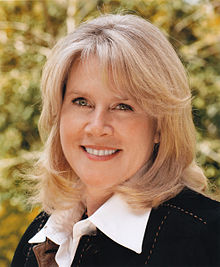Tipper Gore
Tipper Gore | |
|---|---|
 Official portrait, June 2009 | |
| Second Lady of the United States | |
| In role January 20, 1993 – January 20, 2001 | |
| Vice President | Al Gore |
| Preceded by | Marilyn Quayle |
| Succeeded by | Lynne Cheney |
| Personal details | |
| Born | August 19, 1948 Washington, D.C., U.S. |
| Political party | Democratic |
| Spouse(s) | Al Gore (1970–2010, separated)[1] |
| Children | 4 |
Mary "Tipper" Elizabeth Gore (née Aitcheson; born August 19, 1948) is an American author, photographer, writer, and educator. She was the second lady of the United States from 1993 to 2001 as the wife of the 45th vice president of the United States, Al Gore.
Early life and education[change | change source]
Mary Elizabeth Aitcheson was born on August 19, 1948 in Washington D.C. to John Aitcheson Jr. and Margaret Carlson Aitcheson. She later grew up in Arlington, Virginia and she was later raised by both her mother and grandmother after her parents divorced.
She attended schools and universities such as, St. Stephens and St. Agnes School, Garland Junior College, Boston University, Vanderbilt University, and George Peabody College. Aitcheson later pursued and graduated with both a Bachelor of Arts and Master of Arts.
Marriage and family[change | change source]
Aitcheson met Al Gore at his senior prom in 1965 and they began dating afterwards. On May 19, 1970, they married at the Washington National Cathedral. They have four children named, Karenna, Kristin, Sarah, and Albert Gore lll.
Second Lady of the United States (1993–2001)[change | change source]
Gore assumed the role and duties as the second lady of the United States on January 20, 1993 succeeding, Marilyn Quayle when her husband inaugurated as the 45th vice president of the United States. As second lady, Tipper served as the mental health policy advisor to the president. Her goals were to destroy the stigma surrounding mental illness and to bring awareness to the need for affordable mental health care. In 1999, she hosted the first White House conference on mental health. That same year, she launched the National Mental Health Awareness Campaign to encourage Americans to seek treatment for mental illness.
Along with her work in mental health, Gore was a part of several other initiatives during her time as second lady. Tipper visited a refugee camp and an orphanage in Zaire on a personal trip to provide aid in the aftermath of the Rwandan genocide. She stayed in a United Nations camp to assist doctors and aid workers and also made an official visit to Honduras in 1998 following Hurricane Mitch to volunteer, bring medical supplies, and to survive the damage.
Gore was actively involved in her presidential campaign in 2000, making her own campaign stops and media appearances. She also acted as an advisor and hired Tony Coelho as chairman in part of her husband's presidential campaign. Her husband lost and was defeated by George W. Bush in a close tie in the race, due to a Florida recount. Gore served as the second lady from 1993 until her husband's term ended in 2001.
References[change | change source]
- ↑ Schelzig, Erik (January 6, 2010). "Al and Tipper Gore to separate after 40 years". Associated Press through Yahoo News. Retrieved March 31, 2013.

